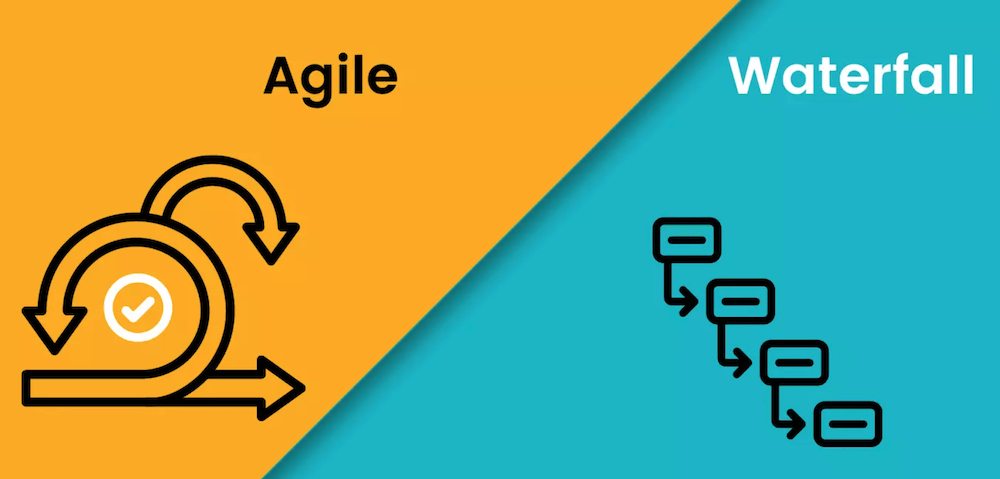Agile isn’t an unfamiliar term for multiple companies, especially IT businesses.
Digital.ai, an intelligent value stream management platform. This platform reported a surprisingly considerable increase in Agile usage from 37% (2020) to 86% (2021).
If you’re a new entrepreneur in the tech industry, learning about a suitable management method is a must to boost productivity and execute tasks efficiently and timely.
In this article, we’ll detail:
- Definition and importance of agile;
- Pros and cons of agile methodology;
- Key differences between agile and other management solutions.
Such information, to some extent, contributes to your final decision of whether or not agile is the right approach for your development team.
What is Agile and Why Does It Matter?
Agile is a common methodology for managing projects. It allows the whole project development process to be conducted in continuous phases called “iterations”.
In other words, rather than customizing a whole product in one go, agile development teams often break it into different pieces that can be tested and advanced separately before they move to the next cycle. This ensures each part of the software will be conceptualized, developed, and receive real-time feedback from customers.

Not only is the agile methodology widely applied by digital businesses of all kinds, but its application is also extended across other segments where feasible increments can be built. This approach proves greatly important because it helps software projects work seamlessly and builds required values for end-users resourcefully.
Having said that, development teams may encounter some potential difficulty when working on this approach. So, you should get to know the pros and cons of agile methodology if you want to learn about this management solution.
You should know this before knowing about the
pros and cons of agile methodology: What is Agile Software development?The Pros of Agile Development
The agile method comes with several possible benefits as follows:
1. Quick Delivery
Agile helps a development team deliver a product faster and more efficiently.
Developing a product, especially software, is an ongoing process. Any deliverable aims at meeting the increased demands of targeted customers. So building a digital solution based on agile means team members will carry out each small increment of the Product Backlog faster in a series of repetitive cycles. They accordingly get a quick response from end-users and a product owner for improvements. A whole project will be repeatedly executed during iterations until the desired outcome is reached.
2. Cooperation
The agile methodology requires the involvement of different people in each iteration.
Not only does the presence of a software development team matter, but a product owner also needs to join a process from the beginning. Through brainstorming procedures and project management tools, all parties can come up with viable ideas and track how work is progressing.
Agile promotes collaborative efforts and creativity between those involved to avoid misunderstandings and guarantee products are built efficiently from scratch.
3. Adaptability
As the ultimate goal of any deliverable is to satisfy end-user expectations, constantly altering features is a necessity to perfect a product. During the agile development process, you can make flexible changes in each iteration without interfering with what you’ve developed before. This property sets agile apart from a traditional approach like Waterfall whose phase is completely dependent on the previous one.
4. Rapid Detection of Defects
Apart from easy modifications, working on small increments allows your team to precisely identify problems without hassle. Beyond that, you can easily correct flaws and resolve issues, for example, a mobile app’s layout or essential functionality.
5. Constant Improvement
The agile methodology enables you to assess and enhance a product’s UX/UI design and functions in real-time. This helps save much time and cost in modifying a product’s features or correcting defects. Based on a client’s feedback or interactions, you can perpetually perfect the product without rebuilding a completely new version.
6. Transparency
Because many people with different roles engage in the agile development process, everything from conceptualization to testing and launch is transparently conducted. Also, all work will be continuously shown to those involved to ensure it goes on the right track and no activity is hidden.
FURTHER READING:▶ Agile Software Development Life Cycle Guide
▶ 5 Agile Project Management Tools That You Should Know in 2022
The Cons of Agile Development
However, agile teams may be confronted with unexpected drawbacks, including:
1. Short-term Planning
If you have no definite goals and directions about a potential product from the beginning, agile comes into play to help create your expected deliverable. For this reason, this approach often accompanies ephemeral plans that help you promptly respond and adapt to new or unexpected events.
However, this nature also turns agile into a nuisance. Especially in case you have weak core visions, you may fail to create reliable enough plans to react well with real-time feedback.
2. No Specific Deadlines and Costs
Another downside is that agile teams have difficulty clarifying how long each iteration lasts or how much a total project costs. This is primarily attributed to unexpected changes arising during the development process.
The dearth of detailed deadlines and budget can make final products published later than expected and faced with unexpectedly incurred costs.
3. Ease of Falling Off Track
One problem of working with the agile method is the possibility of lacking cohesion and going away from ultimate goals.
Indeed, over the agile development process, little planning is required and new changes can be made to meet the growing needs of consumers. Without a consistent strategy, a strong vision, and an excellent leader, a whole project can easily fall off the predetermined plan. Your team consequently fails to build a product that has coherent components and meets preset requirements.
Difference Between Agile and Other Methodologies
There is a wide selection of project management models, apart from Agile, like Waterfall, Kanban, or Lean Software Development.
Such modern approaches as Gantt Chart or Scrum are initially developed from Agile. So they share some similar philosophies with Agile.
Having said that, there are several obvious differences between them.

For example, Scrum is specifically designed for “sprints”, the shortest cycles of time. A scrum team also has fewer members, primarily involving a product owner, software developers, and a scrum master who functions as a mediator between all members.
Meanwhile, Gantt Chart is a popular method to help team members visualize their work. This method allows your team to illustrate all activities and their timeframe through a diagram.
Besides these modern management solutions, your team can factor in traditional approaches, typically Waterfall. The latter is more appropriate for those with definite goals and requirements. Each stage is dependently built on the deliverables of the previous phase. Thus, making modifications in traditional models is extremely tricky.
Recommended reading: 7 Software Project Management Methodologies Besides Agile
Is the Agile Methodology Right for Your Team?

Agile is not for everyone. This methodology best suits small, adaptable projects that are managed by teams with strong leadership skills and fluid communication styles.
The agile approach can be less successful when projects become more complicated and scale-up. This is because in this case, the project management mechanism is solidified whereas processes are more systemized and harder to change.
Having said that, agile can still be applied in large, complex projects at times. To use this modern approach resourcefully, you need a robust core team that helps projects to be delivered on time and within budget.
To know whether this project management solution is proper for your business, you should ponder:
- kind of company you’re operating;
- the complexity of projects you’re planning.
Beyond that, it’s essential to analyze the pros and cons of agile methodology. We hope that this analysis result from Designveloper helps identify whether your team takes advantage of agile. Besides, it can be capable of handling its accompanying drawbacks.
The post Pros and Cons of Agile Methodology: Which Team Should Apply This Model? appeared first on Designveloper.
February 18, 2022 at 09:40AM











No comments:
Post a Comment